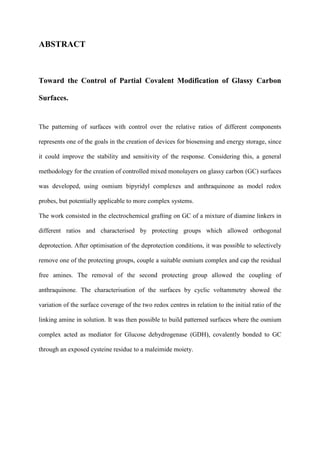Recommended
Sensor Development Exploiting Graphite-Epoxy Composite As Electrode Material. 

Sensor Development Exploiting Graphite-Epoxy Composite As Electrode Material. Sociedade Brasileira de Pesquisa em Materiais
Recommended
Sensor Development Exploiting Graphite-Epoxy Composite As Electrode Material. 

Sensor Development Exploiting Graphite-Epoxy Composite As Electrode Material. Sociedade Brasileira de Pesquisa em Materiais
10.1016-j.mssp.2015.01.037-Electrochemical investigation of graphene_nanoporo...

10.1016-j.mssp.2015.01.037-Electrochemical investigation of graphene_nanoporo...Mahdi Robat Sarpoushi
More Related Content
Similar to Thesis abstract
10.1016-j.mssp.2015.01.037-Electrochemical investigation of graphene_nanoporo...

10.1016-j.mssp.2015.01.037-Electrochemical investigation of graphene_nanoporo...Mahdi Robat Sarpoushi
Similar to Thesis abstract (20)
Corrosion Inhibition of Carbon Steel In Sulfuric Acid by Sodium Caprylate

Corrosion Inhibition of Carbon Steel In Sulfuric Acid by Sodium Caprylate
IRJET- Literature Review on Energy Storage Materials

IRJET- Literature Review on Energy Storage Materials
Optical Control of Selectivity of High Rate CO2 Photoreduction Via Interband-...

Optical Control of Selectivity of High Rate CO2 Photoreduction Via Interband-...
C3N5: A Low Bandgap Semiconductor Containing an Azo-Linked Carbon Nitride Fra...

C3N5: A Low Bandgap Semiconductor Containing an Azo-Linked Carbon Nitride Fra...
C3N5: A Low Bandgap Semiconductor Containing an Azo-Linked Carbon Nitride Fra...

C3N5: A Low Bandgap Semiconductor Containing an Azo-Linked Carbon Nitride Fra...
10.1016-j.mssp.2015.01.037-Electrochemical investigation of graphene_nanoporo...

10.1016-j.mssp.2015.01.037-Electrochemical investigation of graphene_nanoporo...
Flexible all-carbon photovoltaics with improved thermal stability

Flexible all-carbon photovoltaics with improved thermal stability
TRIBOLOGICAL CHARACTERISTICS,ELECTRICAL PROPERTIES 

TRIBOLOGICAL CHARACTERISTICS,ELECTRICAL PROPERTIES
Metal-organic hybrid: Photoreduction of CO2 using graphitic carbon nitride su...

Metal-organic hybrid: Photoreduction of CO2 using graphitic carbon nitride su...
Metal-organic hybrid: Photoreduction of CO2 using graphitic carbon nitride su...

Metal-organic hybrid: Photoreduction of CO2 using graphitic carbon nitride su...
Metal-organic hybrid: Photoreduction of CO2 using graphitic carbon nitride su...

Metal-organic hybrid: Photoreduction of CO2 using graphitic carbon nitride su...
Room-temperature synthesis of 3-dimentional Ag-graphene hybrid hydrogel with ...

Room-temperature synthesis of 3-dimentional Ag-graphene hybrid hydrogel with ...
Tailored interactions of the secondary coordination sphere enhance the hydrol...

Tailored interactions of the secondary coordination sphere enhance the hydrol...
Multistage Activation of Anthracite Coal-Based Activated Carbon for High-Perf...

Multistage Activation of Anthracite Coal-Based Activated Carbon for High-Perf...
Thesis abstract
- 1. ABSTRACT Toward the Control of Partial Covalent Modification of Glassy Carbon Surfaces. The patterning of surfaces with control over the relative ratios of different components represents one of the goals in the creation of devices for biosensing and energy storage, since it could improve the stability and sensitivity of the response. Considering this, a general methodology for the creation of controlled mixed monolayers on glassy carbon (GC) surfaces was developed, using osmium bipyridyl complexes and anthraquinone as model redox probes, but potentially applicable to more complex systems. The work consisted in the electrochemical grafting on GC of a mixture of diamine linkers in different ratios and characterised by protecting groups which allowed orthogonal deprotection. After optimisation of the deprotection conditions, it was possible to selectively remove one of the protecting groups, couple a suitable osmium complex and cap the residual free amines. The removal of the second protecting group allowed the coupling of anthraquinone. The characterisation of the surfaces by cyclic voltammetry showed the variation of the surface coverage of the two redox centres in relation to the initial ratio of the linking amine in solution. It was then possible to build patterned surfaces where the osmium complex acted as mediator for Glucose dehydrogenase (GDH), covalently bonded to GC through an exposed cysteine residue to a maleimide moiety.
